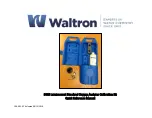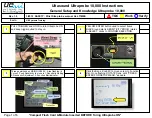
28
OM131
Chapter 2
P1939-OM-131 R11
2.5.1
Inhale / exhale hoses
The outer hose ducts on top of the SLS System Backpack are connected to the Helmet by two large
bore, fabric reinforced hoses (Fig 2.11, Item 2). These are fitted with threaded (O-ring type)
connectors at each end. A second pair of shorter hoses (Fig 2.11, Item 3) connect the inner hose
ducts to the counterlungs, mounted one on each of the diver’s shoulders.
A small stainless steel braided hose (Fig 2.11, Item 1) provides the supply of umbilical gas for the
SLS System single stage regulator. It runs between the Helmet side-block supply fitting and the
single stage regulator inside the Backpack. It is equipped with a quick-connect fitting in the middle of
the hose to facilitate diver dressing and undressing.
2.5.2
Hot water system
Addition of a simple splitter block to the diver’s umbilical hot water hose allows a small flow of water
to be diverted into the SLS System Backpack, via the quick-connect hose assembly (Fig 2.11, Item
4). This water keeps the CO2 scrubber canister warm, ready to start work if required. After passing
through the Backpack, the water can then be connected to a DSI shroud heater for primary gas
heating. The connection for this is via a quick connect located on the top of the Backpack (Fig 2.11,
Item 4).
The diver’s Helmet demand regulator will normally require a shroud heater when diving deeper than
around 200 msw. A hot water supply to the SLS System Backpack is required at
all
diving depths.
Two splitter blocks are available for use with the SLS System:
1.
Divex Part No. D2665 is the standard splitter used for operations between 50 and 450 msw,
with or without the helmet demand regulator heating shroud.
2.
Divex Part No. D2664 is used for extreme deep diving operations (>450 msw).
N
OTE
Prior to June 2004 Splitter block assy, D2665 covered the depth range 50-200msw while D2664 was
specified for operational depths of 200 to 450 msw.
The requirements for the supply of hot water will vary, dependant on diving depth. Higher flows and
temperatures will be required at deeper depths. As a general rule a hot water flow should be
provided per diver, of a flow between 10 and 30 lpm. Users should check with their Safety
Department to obtain the specific requirements.
Extensive testing of the SLS System has been carried out at various diving research centres,
including NUTEC in Bergen, the National Hyperbaric Centre in Aberdeen and the US Navy
Experimental Diving Unit in Panama City. The recommendations for the use of hot water have been
based on these results.
When diving in Norwegian waters, SINTEF UNIMED conducted a study (Report No. STF23
A92012) on the design requirements for Diving Bells. This report requires that a flow of hot water of
30 l/min per diver should be available from a diving bell. The SLS System formed a part of this study
and these flows took into account SLS System hot water requirements.
Some Divers have complained of feeling cold when using the SLS system and therefore disconnect
the SLS Backpack.
However the SLS does not 'use' any water - it is merely diverted through the backpack and back to
the helmet. Once the thermal regenerator has warmed up, there is virtually no heat requirement and
the unit therefore does not detract from the heat supplied to the diver.
Summary of Contents for Divex SLS Mk IV
Page 2: ...Intentionally Blank...
Page 4: ...ii OM131 Approval Sheet P1939 OM 131 R11 Intentionally Blank...
Page 6: ...iv OM131 Preface P1939 OM 131 R11 Intentionally Blank...
Page 8: ...vi OM131 List of Abbreviations P1939 OM 131 R11 Intentionally Blank...
Page 10: ...viii OM131 Warnings P1939 OM 131 R11 Intentionally Blank...
Page 12: ...x OM131 Table of Contents P1939 OM 131 R11 Intentionally Blank...
Page 15: ...OM131 3 P1939 OM 131 R11 Chapter 1 Fig 1 1 SLS System Mk IV...
Page 16: ...4 OM131 Chapter 1 P1939 OM 131 R11 Fig 1 2 SLS system layout...
Page 32: ...20 OM131 Chapter 2 P1939 OM 131 R11 Fig 2 4 Two stage regulator Fig 2 5 Spool valve...
Page 42: ...30 OM131 Chapter 2 P1939 OM 131 R11 Intentionally Blank...
Page 53: ...OM131 41 P1939 OM 131 R11 Chapter 3 Fig 3 3 Hose Lanyards...
Page 54: ...42 OM131 Chapter 3 P1939 OM 131 R11 Fig 3 4 SLS System Mk IV Rear View...
Page 55: ...OM131 43 P1939 OM 131 R11 Chapter 3 Fig 3 5 SLS System Mk IV Front View...
Page 64: ...52 OM131 Chapter 3 P1939 OM 131 R11 Intentionally Blank...
Page 82: ...70 OM131 Chapter 4 P1939 OM 131 R11 Fig 4 7 Annual Maintenance Two Stage Regulator...
Page 86: ...74 OM131 Chapter 4 P1939 OM 131 R11 Fig 4 8 Annual Maintenance Single Stage Regulator...
Page 109: ...OM131 97 P1939 OM 131 R11 Chapter 5 Fig 5 2 Backpack Assembly Drawing P1939229S1...
Page 111: ...OM131 99 P1939 OM 131 R11 Chapter 5 Fig 5 4 Scrubber Housing Assembly Drawing P1939131S1...
Page 118: ...106 OM131 Chapter 5 P1939 OM 131 R11 Fig 5 9 SLS System Mk IV Gas Schematic Drawing P193940S1...
Page 123: ...OM131 111 P1939 OM 131 R11 Chapter 5 Fig 5 14 SLS System Mk IV Bottle Assembly...
















































